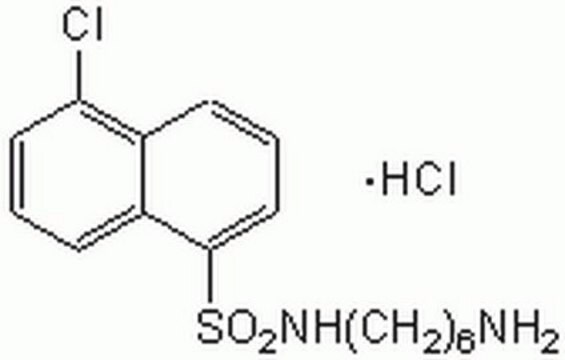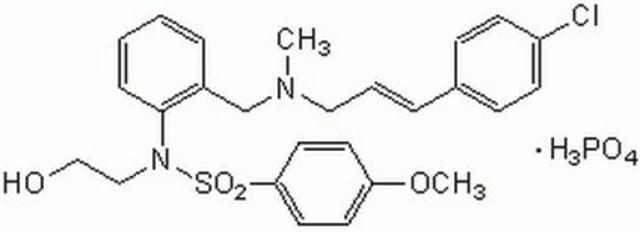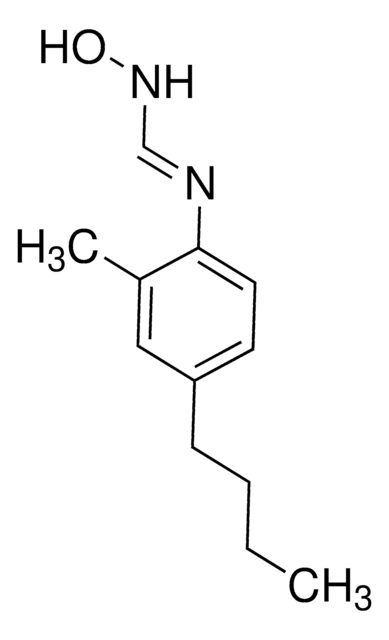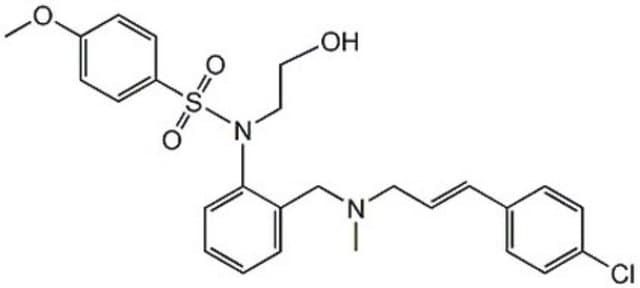422706
KN-62
A cell-permeable, reversible, and selective inhibitor of CaM kinase II (Ki = 900 nM for rat brain CaM kinase II) that binds directly to the calmodulin binding site of the enzyme.
Synonym(e):
KN-62, 1-[N,O- bis-(5-Isoquinolinesulfonyl)-N-methyl-L-tyrosyl]-4-phenylpiperazine, P2X Antagonist II, Purinergic Receptor P2X Antagonist II, 1-[N,O-bis-(5-Isoquinolinesulfonyl)-N-methyl-L-tyrosyl]-4-phenylpiperazine, P2X Antagonist II, Purinergic Receptor P2X Antagonist II
About This Item
Empfohlene Produkte
Qualitätsniveau
Assay
≥95% (HPLC)
Form
solid
Hersteller/Markenname
Calbiochem®
Lagerbedingungen
OK to freeze
desiccated
protect from light
Farbe
off-white
Löslichkeit
methanol: 5 mg/mL
DMSO: soluble
Versandbedingung
ambient
Lagertemp.
2-8°C
InChI
1S/C38H35N5O6S2/c1-41(50(45,46)36-11-5-7-29-26-39-19-17-33(29)36)35(38(44)43-23-21-42(22-24-43)31-9-3-2-4-10-31)25-28-13-15-32(16-14-28)49-51(47,48)37-12-6-8-30-27-40-20-18-34(30)37/h2-20,26-27,35H,21-25H2,1H3
InChIKey
RJVLFQBBRSMWHX-UHFFFAOYSA-N
Allgemeine Beschreibung
Biochem./physiol. Wirkung
cam kinase 2
Warnhinweis
Angaben zur Herstellung
Rekonstituierung
Sonstige Hinweise
Kato, M., et al. 1992. Neurosci. Lett.129, 47.
Ishii, A., et al. 1991. Biochem. Biophys. Res. Commun.176, 1051.
Ito, I., et al. 1991. Neurosci. Lett.121, 119.
Tokumitsu, H., et al. 1990. J. Biol. Chem.265, 4315.
Rechtliche Hinweise
Lagerklassenschlüssel
11 - Combustible Solids
WGK
WGK 3
Flammpunkt (°F)
Not applicable
Flammpunkt (°C)
Not applicable
Analysenzertifikate (COA)
Suchen Sie nach Analysenzertifikate (COA), indem Sie die Lot-/Chargennummer des Produkts eingeben. Lot- und Chargennummern sind auf dem Produktetikett hinter den Wörtern ‘Lot’ oder ‘Batch’ (Lot oder Charge) zu finden.
Besitzen Sie dieses Produkt bereits?
In der Dokumentenbibliothek finden Sie die Dokumentation zu den Produkten, die Sie kürzlich erworben haben.
Unser Team von Wissenschaftlern verfügt über Erfahrung in allen Forschungsbereichen einschließlich Life Science, Materialwissenschaften, chemischer Synthese, Chromatographie, Analytik und vielen mehr..
Setzen Sie sich mit dem technischen Dienst in Verbindung.








